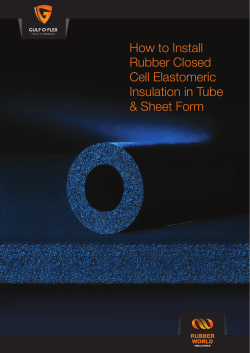
Background
PIMA Technical Bulletin #202 Polyurethane and Polyiso: What is the Difference? About Polyiso Insulation Background Polyiso is a rigid foam insulation used in over 70% of commercial roof construction, in commercial sidewall construction and in residential construction. The Benefits of using Polyiso include: • Low environmental impact • Virtually no global warming potential • Zero ozone depletion potential • Cost effective, optimized energy performance • Long service life • Recyclable through reuse • Recycled content (amount varies by product) • Regional materials (nationwide production network) • Meets new continuous insulation (ci) standards • Quality Mark™ certified LTTR-values • High R-value per inch of thickness • Thinner walls and roofs with shorter fasteners • Excellent fire test performance • Extensive building code approvals • Preferred insurance ratings • Compatible with most roof and wall systems • Moisture resistance • Dimensional stability • Compressive strength PIMA and polyiso products have received many environmental awards. These include an honorable mention in the Sustainable Buildings Industry Council’s (SBIC) - “Best Practice” Sustainability Awards Program and the U.S. EPA’s Climate Protection Award for the association’s leadership in promoting energy efficiency and climate protection. The EPA also awarded PIMA and its members the Stratospheric Ozone Protection Award for “leadership in CFC phase-out in polyiso insulation and in recognition of exceptional contributions to global environmental protection.” Polyurethane plastics, originally developed in the 1930s, were primarily used in military and aerospace applications until the 1950s. Their application in consumer and industrial products became popular in the late 1950s, when they were used mostly for cushioning (flexible foam), coatings (polyurethane modified oil based), and thermal insulation applications (rigid foam). In the 1970s, there was a growth in the use of rigid polyurethane (PUR for short) foam thermal insulation in refrigerators and panel products, and in spray applied foam as building insulation. Typically, roof systems containing rigid polyurethane roof insulation needed a thermal barrier such as perlite or gypsum board to pass the rigorous Factory Mutual Calorimeter fire test (FM 4450). Development of new chemical recipes and catalysts in Europe and in the United States resulted in a next generation product called polyisocyanurate foam (PIR for short), or polyiso. Polyiso foam first appeared on the US market in the late 1970s. A major advantage of polyiso foam was its ability to pass the FM Calorimeter fire test without a thermal barrier. What are the Differences Between Rigid Polyurethane and Rigid Polyiso Foams Today? To start, a simple chemistry lesson is needed. Polyurethanes are produced as a result of a chemical reaction between polyol and isocyanate. This reaction must be carefully controlled and special recipes (containing the polyol, isocyanate, blowing agent, catalysts, and surfactants) are needed for each type of product. The amount of polyol and isocyanate is matched according to a chemical equivalent weight. For a standard polyurethane, the amount of isocyanate used is usually about 105% of that needed to exactly match the chemical equivalent of the polyol. A foam made with that recipe would be said to have an index of 105. Theoretically, polyisocyanurates can be produced with no polyol, using only isocyanate and catalysts - blowing agents and surfactants. Instead of reacting with the polyol, the isocyanate reacts with itself to form a highly crosslinked thermosetting polymer with a ring-like structure. For commercial polyiso foam, the polyurethane is modified with polyisocyanurate, creating superior fire resistance and maintaining toughness. The index of polyiso foam roof insulation products today is about 250. This means that the amount of isocyanate is 250% of that needed to react with any polyol used; the extra 150% makes polyisocyanurate and minor amounts of other polymers. What Exactly is Polyiso Foam Insulation? Today’s polyiso products are a mixture of rigid polyurethane and polyisocyanurate, with the advantages of both products. Sometimes, they are referred to as PUR/PIR foams. These products deliver superior R-value per inch, excellent performance in code required fire tests, and compatibility with most roofing and sheathing systems. Polyiso insulation is produced with facers that are tailored to match end use. For example, foil faced polyiso is most commonly used as wall sheathing in residential construction or in masonry cavity wall construction. Roof applications rely on glass fiber facers or glass fiber reinforced organic felt facers. PUR/PIR foams are thermoset plastics, which means they do not melt and flow when exposed to high temperatures. This makes these products ideal for construction applications where fire resistance is necessary. Polyiso foam insulation products are used in both commercial and residential buildings as thermal insulation in roof and wall systems. Polyiso insulation products are easy to specify. These products meet the requirements of ASTM C1289 Standard Specification for Faced Rigid Cellular Polyisocyanurate Thermal Insulation Board and CAN/ULC-S704 Standard for Thermal Insulation, Polyurethane and Polyisocyanurate, Boards, Faced. PIMA For over 20 years, PIMA (Polyisocyanurate Insulation Manufacturers Association) has served as the unified voice of the rigid polyiso industry proactively advocating for safe, cost-effective, sustainable and energy efficient construction. PIMA produces technical bulletins in an effort to address frequently asked questions about polyiso insulation. PIMA’s technical bulletins are published to help expand the knowledge of specifiers and contractors and to build consensus on the performance characteristics of polyiso. Individual companies should be consulted for specifics about their respective products. PIMA’s membership consists of manufacturers and marketers of polyiso insulation and suppliers to the industry. Our members account for a majority of all of the polyiso produced in North America. SAFETY Polyiso insulation, like wood and other organic building materials, is combustible. Therefore, it should not be exposed to an ignition source of sufficient heat and intensity (e.g., flames, fire, sparks, etc.) during transit, storage or product application. Consult the product label and/or the PIMA members’ Material Safety Data Sheets (MSDS) for specific safety instructions. In the United States, follow all regulations from OSHA, NFPA and local fire authorities; in Canada, follow all regulations from Health Canada Occupational Health and Safety Act (WMHIS) and local fire authorities. F o r m o r e i n f o r m a t i o n o n p o l y i s o c y a n u r a t e i n s u l a t i o n , v i s i t w w w. p o l y i s o . o r g PIMA 7315 Wisconsin Avenue, Suite 400E, Bethesda, Maryland 20814 Phone: 301.654.0000 • Fax: 301.951.8401 www.polyiso.org • pima@pima.org 7/11 TB #202 2
© Copyright 2025







![De Poef Wope [woolen rope] your seat in](http://cdn1.abcdocz.com/store/data/000105306_2-59a13917e66af3eefc367f3fcf9d5673-250x500.png)


